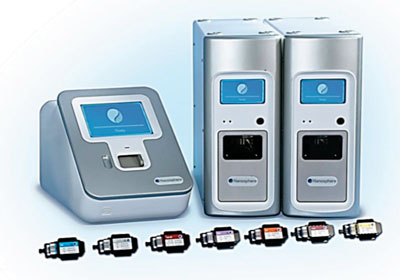Molecular Diagnostics Identify Resistance Biomarkers of Bloodstream Infection
By LabMedica International staff writers
Posted on 02 May 2016
Molecular diagnostics allow for rapid identification and detection of resistance markers of bloodstream infection, with a potential for accelerated antimicrobial optimization and improved patient outcomes.Posted on 02 May 2016
Bloodstream infections (BSIs) are associated with significant health care cost and prolonged hospital stays. Rapid initiation of effective antimicrobial treatment is a mainstay of therapy because delay is associated with increased morbidity and mortality. Novel methods that allow for rapid identification of pathogens, with the ability to detect resistance markers, are, therefore, promising tools to significantly affect overall patient care.

Image: The Verigene BC-GP assay system for the rapid detection of bloodstream infections (Photo courtesy of Nanosphere).
Scientists at the Keck School of Medicine (Los Angeles, CA, USA) determined the impact of a molecular blood-culture assay that identifies a broad-spectrum of pathogens and resistance markers in pediatric patients with gram-positive bloodstream infections. The team collected data on the time to antimicrobial optimization, the length of hospitalization, and the hospital cost following implementation of a rapid assay were prospectively collected and compared with corresponding preimplementation data.
Blood culture samples from pediatric patients, aged one day to 21 years, who presented with a blood culture positive for a gram-positive bacteria targeted by the Gram-Positive Blood Culture Nucleic Acid Test (BC-GP, Nanosphere Inc., Northbrook, IL, USA) were included. The microbiology laboratory operates and offers all tests 24 hours/day, seven days/week. Input from the infectious disease team was dependent on consultation request. Institutional policy mandates a consultation for all BSIs caused by Staphylococcus aureus. All blood culture specimens were obtained and processed using the BacT/ALERT (bioMérieux; Durham, NC, USA) automated blood culture system.
There were 440 episodes from 383 patients included: 221 preimplementation episodes and 219 postimplementation episodes. The BC-GP assay implementation significantly reduced the average time of Gram stain report to organism identification from 24.8 hours to 3.8 hours. In addition, time from Gram stain notification to detection of methicillin-resistant S. aureus, methicillin-resistant S. epidermidis, and vancomycin-resistant enterococci was significantly shortened by 45.9 hours following BC-GP assay implementation (49.7 hours versus 3.8 hours). Median length of stay for patients admitted to general pediatric units was 1.5 days shorter, and median hospital cost was USD 3,757 less after implementation. For S. aureus bloodstream infections, median length of stay and hospital cost were decreased by 5.6 days and USD13, 341 respectively.
The authors concluded that implementation of molecular assay for the detection of gram-positive pathogens and resistance markers significantly reduced time to identification and resistance detection, resulting in accelerated optimization of therapy, shorter length of stay, and decreased health care cost. Implementation of the BC-GP assay contributed to a reduction in time to appropriate antimicrobial therapy, regardless of patient population, and a decrease in length of stay (LOS) and overall hospital costs among patients without other significant comorbidities. Further integration with the antimicrobial stewardship team may further improve time to optimal therapy and patient outcome. The study was published in the March 2016 issue of the journal Archives of Pathology & Laboratory Medicine.
Related Links:
Keck School of Medicine
Nanosphere
bioMérieux













.jpg)